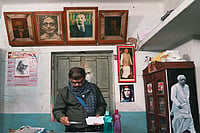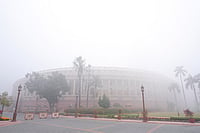Hindutva was given a fair run in HP. Despite PM Atal Behari Vajpayee’s warnings to his party and the rest of the Sangh parivar not to let Hindutva be defined in culturally exclusive terms, in the end the BJP did send Narendra Modi, its reigning champion of Muslim-bashing, to campaign for the party in Himachal. Modi’s presence and his hate-filled rants found no echo in the people. What the voters were concerned about was the growing stress in their daily lives and the steady deterioration of the future prospects of their children in an economy that was simply not generating new jobs. Prem Kumar Dhumal’s government had not proved even an iota better than that of his Congress predecessor, Virbhadra Singh. So it was thrown out. As if to underline the message that performance (or the lack thereof) was what concerned the voters most, the BJP lost two by-elections in UP as well.
To gauge the impact of the HP verdict, it is necessary to assess what would have happened had the BJP won. Gujarat had shown that if Hindu chauvinism can be stoked to a high enough pitch, it can overcome the anti-incumbency factor which is the dominant feature of Indian politics today. By-elections in December 2001 had shown that despite its 10 per cent lead over the Congress in the previous state election, the BJP’s hold on power in Gujarat was slipping. To Modi, who is more VHP than BJP, the Godhra massacre came as a political gift. Ignoring the cautionary advice of both Vajpayee and L.K. Advani, he played upon anti-Muslim sentiment with the skill of a snake-charmer to add a full 5 per cent to the BJP’s vote and maintain his party’s 10 per cent lead over the Congress.
Himachal was the next state where the Modi thesis could be put to test. A victory for the BJP was essential if Modi’s brand of Hindutva was to triumph within the party. Dhumal had ruled for five years and anti-incumbency dictated that the Congress should come to power next. But the gap in votes between the two parties was small, so if the appeal to Hindutva had even a marginal impact on the voters, it could bring the BJP back to power. Had that happened, there would have been no holding back Modi and his supporters. The BJP would have undergone a none too quiet transformation from within and become a watered-down version of the VHP.
In that case, in the four crucial state elections due at the end of this year—in Delhi, MP, Rajasthan and Chhattisgarh—the party would have made Muslim-baiting and the establishment of a ‘Hindu rashtra’ its main campaign plank. In these states, in contrast to Himachal, Hindutva would have been assisted by the anti-incumbency factor. So even if the BJP had won on the basis of anti-incumbency, the Modi brigade would have claimed it as a victory for their brand of rabid Hindutva. Vajpayee and Advani would have been deprived of any argument to the contrary.
The BJP would then have gone into the 2004 elections with a programme that sought to capitalise on communal polarisation and the baiting of the minorities. The threat this would have posed to India’s unity hardly needs to be stressed. As Vajpayee has stressed times without number, India’s strength lies in its diversity. It can survive and prosper as a single nation only when all of its people, irrespective of caste, ethnicity or creed, believe that they are equal citizens of a secular democracy. This is the pillar the BJP would have found itself committed to demolishing.
The Himachal verdict has largely averted this danger. If the BJP wins the Delhi, Rajasthan and MP elections, as it is very likely to do, it will know that it owes its victory to the anti-incumbency factor and not to an appeal to communal passion. HP has thus vindicated Vajpayee’s thesis that power can be retained only by moderating the Hindutva platform and building stable coalitions with other, secular, parties that face the Congress as the main rival in their home states.
The Himachal victory has also come as a tonic to the Congress party when it desperately needed one. The confusion in the party after its defeat in Gujarat had been mirrored by the silence of its leaders. Within the party, no one has known whether the party should confront the ‘Modi factor’ head-on or trim its sails and adopt some kind of ‘soft Hindutva’, whatever that means. A defeat in Himachal would have immeasurably deepened the confusion and demoralisation within the party. In that condition, it might not have survived a succession of defeats in the four northern states next winter and might have begun to disintegrate, as had happened in January 1998 before Sonia Gandhi stepped in. Had that happened, the BJP’s victory in the general elections of 2004, in its new Modi attire, would have become a foregone conclusion and a ‘Hindu rashtra’ would have been midwifed.
The Himachal verdict has averted this threat. Now, the BJP will not interpret a victory in the north next winter as a vote for Hindutva. The Congress will realise that a defeat there will reflect only the working of the anti-incumbency factor and prepare to take advantage of it at the Centre in the 2004 parliamentary elections. The nation will once again have a genuine choice between two coalitions led by centrist national parties. Indian democracy will therefore continue to live and prosper.























